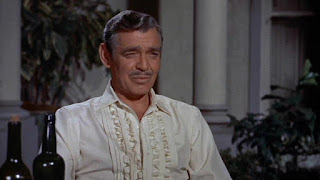 |
| James Stewart |
ANATOMY OF A MURDER (1959). Produced and directed by Otto Preminger.
"
Get off the panties! You've done enough damage." -- Judge Weaver.
Folksy former D. A. Paul Biegler (James Stewart) is importuned by his soused buddy, Parnell (Arthur O'Connell), to defend an Army lieutenant, Manion (Ben Gazzara), after the man shoots and kills a bar owner who allegedly raped his wife, Laura (Lee Remick). The trouble is that Laura seems rather sluttish, Manion has a hair-trigger temper, and the defense that Biegler comes up with -- an irresistible impulse that Manion couldn't control -- may not fly with the jury. And a hot shot prosecutor from out of town, Claude Dancer (George C. Scott), may put the lie to Laura's story in any case.
 |
| Eve Arden and Arthur O'Connell |
Anatomy of a Murder is a frustrating picture. On one hand, it is very entertaining, frank, suspenseful and fast-paced, its nearly three hour length flying by in short order. There are also some excellent performances from Stewart (who in one interview did not seem to see his character as any kind of hero, which he isn't); Remick (who offers one of her best performances, in fact); Gazzara; a splendid Scott, who makes the most of his comparatively brief scenes; and especially O'Connell, who is superb as Parnell -- Stewart, O'Connell and Scott all received Oscar nominations, the last two in support. Eve Arden is also on hand as Biegler's seriously underpaid secretary, and she also makes the most of her scenes with her customary aplomb. Murray Hamilton also scores as a bartender, along with Kathryn Grant as the daughter of the victim, and Don Ross [
Walk the Dark Street] makes his mark as a jailbird who testifies against Manion. Sam Leavitt's [
Advise and Consent] cinematography was also rightly nominated for an Oscar, although I didn't especially care for Duke Ellington's jazz scoring.
 |
| Ben Gazzara |
On the other hand, if you're expecting a neat and tidy story where all of the loose ends are tied up as in a Perry Mason episode, be forewarned that
Anatomy of a Murder is not only ambiguous in its plot line but morally ambiguous as well. This last is no surprise, as the film is based on a novel written by the defense attorney who actually represented someone similar to Lt. Manion and fictionalized the true case. The result in real life was the same as in the movie. Frankly, some people may want to throw something at the TV screen when the film is over, while others will ruefully note that the justice system is imperfect and some people never quite get the justice they deserve.
 |
| George C. Scott and Lee Remick |
Another problem with the picture is that at times it is off-puttingly light-hearted, almost playing like a parody of a courtroom drama. You're gratified when the judge finally tells people that this is a serious matter, although it seems to take him forever to do so. Stewart's "aw shucks" manner becomes a little grating at times. And what on earth is up with that flamboyant cigarette holder than Manion uses in the court room? Judge Weaver is played by an actual judge, Joseph N. Welch, who later became an actor and had three credits. Although his performance is okay, for better or worse he does add to the almost comical tone of some sequences in the picture. Otto Preminger also directed the terrific
Angel Face.
Verdict: Your call. Quite absorbing and well-acted, one of Preminger's better directorial jobs, thought-provoking, but it may have you gritting your teeth. ***.









































